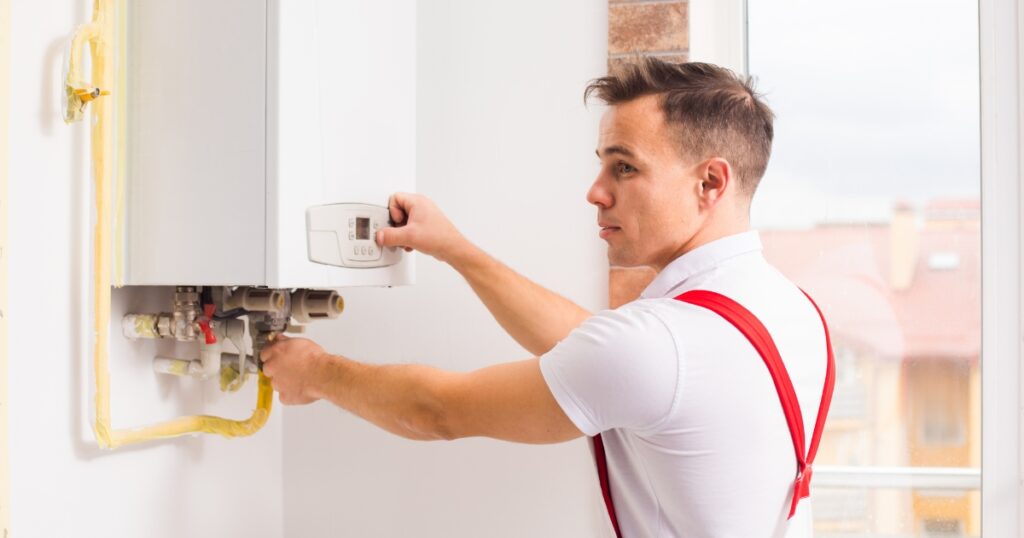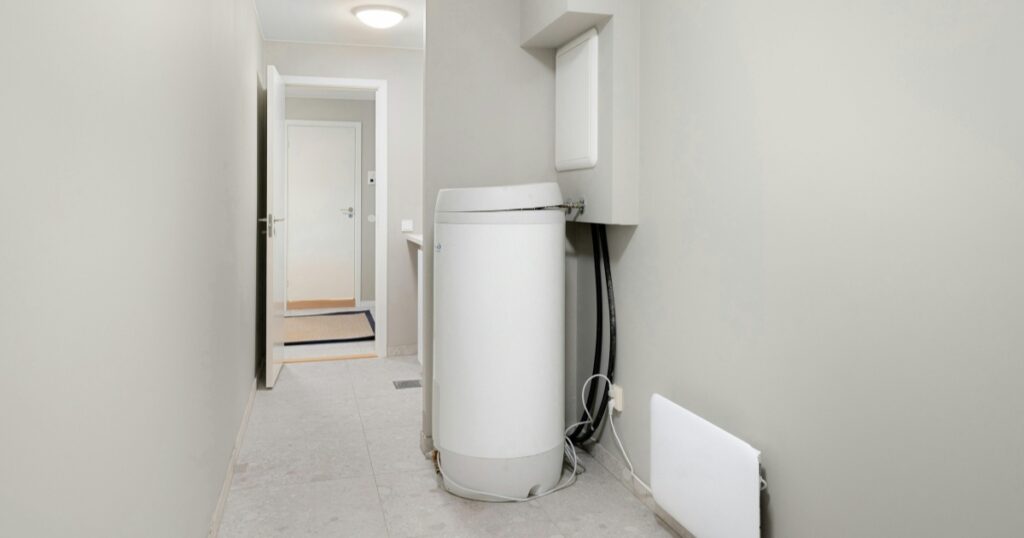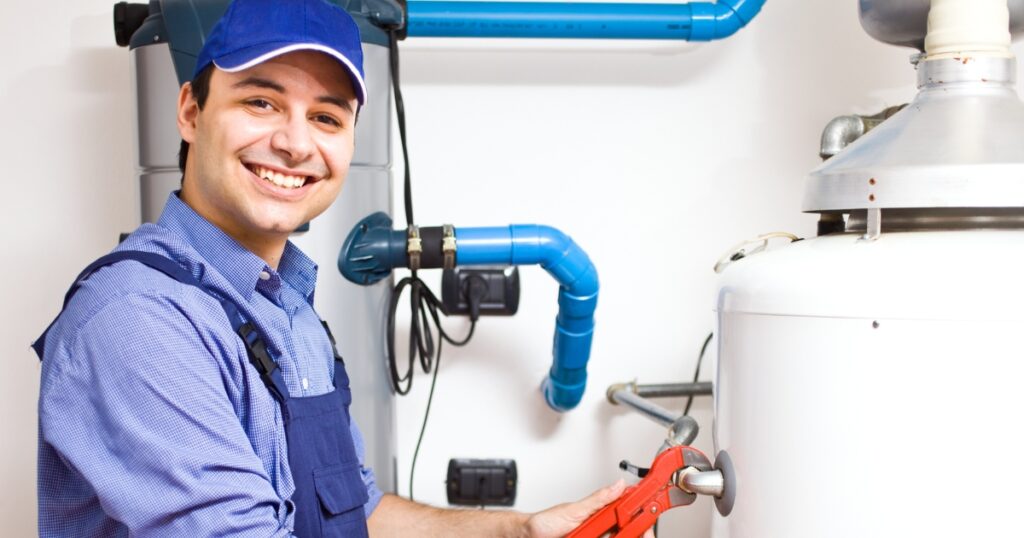Ever felt a bit off about your hot water system lately? You’re not alone, mate. Turns out, getting the fleeing right is crucial for keeping it running safely. This yarn will walk you through spotting and sorting out any niggles with your water heater’s flue or ventilation.
Key Takeaways
- Regular checking and cleaning of your hot water system’s flue and ventilation can stop dangerous gases like carbon monoxide from getting into your home. Make sure to clear away anything that blocks the flow of these gases outside.
- If you spot signs like discolouration around your water heater, soot, strange smells or a pilot light that keeps going out, it could mean there’s a problem with flue or ventilation. Don’t ignore these warnings; they’re telling you something is not right.
- Always open windows or vents when using gas appliances to help keep fresh air flowing in and bad fumes flowing out. This simple action can make a big difference in keeping the air inside your home safe.
- Getting professional checks on your hot water service is key for safety. Experts can spot issues early on before they turn into bigger dangers for you and your family.
- Knowing when it’s time to upgrade your water heater is important too. Newer models are more efficient and safer because they have better venting systems that deal with harmful gases in smarter ways.
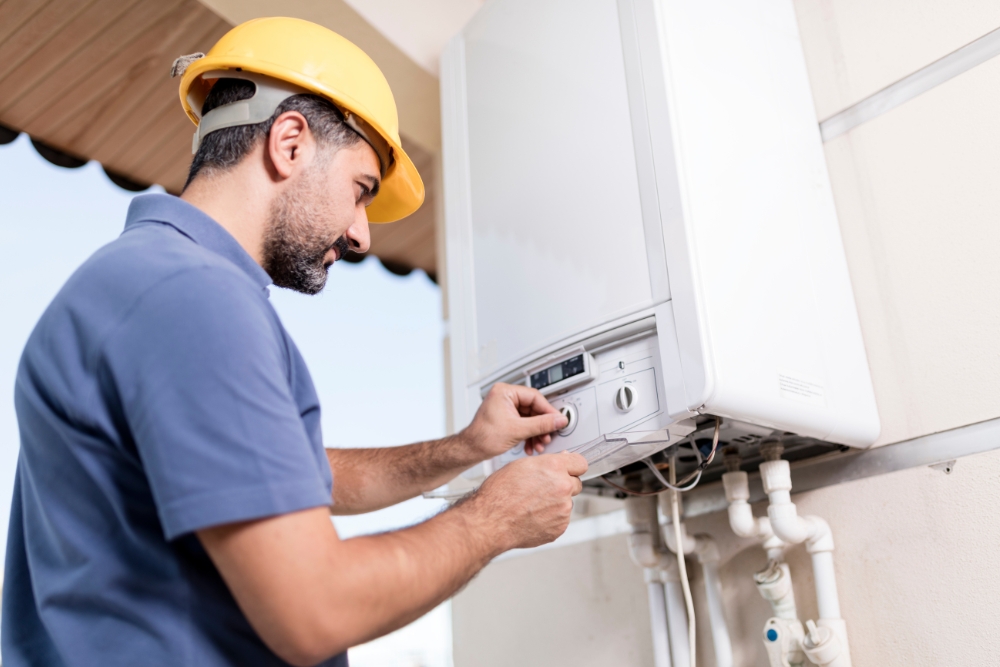
Understanding Flues and Ventilation for Hot Water Service Heaters
Flues are essential in gas water heaters to safely expel combustion gases outside the home. They can be made of metal, plastic, or masonry. Proper ventilation is crucial for removing harmful fumes and maintaining air quality indoors.
What is a Flue?
A flue is an essential part of our hot water systems, especially when using gas heaters. It’s a duct or pipe that carries exhaust gases from our gas water heater to the outside of our home, making sure harmful fumes don’t linger indoors.
This system operates on the principle that hot air rises. By directing it upwards and out, we keep our indoor environment safe from potential hazards like carbon monoxide.
Our homes rely on this critical component for both safety and efficiency in heating water. Fluid water heaters, whether they run on natural gas or LPG, need this venting to operate correctly.
Without proper flueing and ventilation problems could arise with our hot water service. Now let’s explore the different types of ventilation systems for these heaters.
Types of Water Heater Ventilation
Understanding the importance of proper ventilation for water heaters, let’s take a look at the different types of ventilation systems commonly found in homes:
- Natural Ventilation: This system uses convection to move air and relies on the buoyancy of warm air to draw combustion gases out through a flue or chimney.
- Mechanical Ventilation: Utilising fans or blowers, this system helps in expelling exhaust fumes from the water heater, ensuring safe and efficient operation.
- Power Venting: With the assistance of a fan or blower motor, power-vented water heaters expel exhaust gases through a dedicated pipe, offering flexibility in installation locations and improved safety measures.
- Direct Venting: These heaters draw fresh air from outside and expel combustion gases through a sealed vent system, maintaining indoor air quality while promoting safe appliance operation.
- Flue Ducts: Typically used for gas appliances, these vertical ducts carry combustion products from the appliance to the outdoors, preventing the accumulation of harmful fumes inside the home.
Importance of Proper Ventilation
Proper ventilation is crucial for the safe and efficient operation of gas appliances, including hot water systems. Adequate ventilation ensures that harmful fumes are directed outside of the building, preventing them from accumulating indoors and posing health risks to occupants.
It’s essential to understand that flued water heaters require a well-maintained flue to vent these harmful gases safely. Neglecting proper ventilation can lead to restricted airflow or even reversed flue flow, which may result in safety hazards.
Therefore, ensuring proper venting not only maintains a healthy indoor environment but also prevents potential dangers associated with inadequate ventilation.
Maintaining proper ventilation is critical for the safe operation of gas appliances such as hot water systems. Neglecting this aspect can lead to serious safety hazards within your home and compromise the efficiency of your heating system.
Therefore, it’s important to identify signs of inadequate ventilation and take necessary steps to address any issues promptly while considering professional assistance if needed.
Signs of Flue or Ventilation Issues
Discolouration of the water heater and visual signs of dangerous problems indicate potential flue or ventilation issues. Backdrafting concerns are also an important indicator that there may be a problem with your hot water system’s flue or ventilation.
Discolouration of the Water Heater
Water heater discolouration indicates potential ventilation issues. Rusty water or a metallic taste might suggest corrosion in the tank due to improper venting, which can compromise water quality.
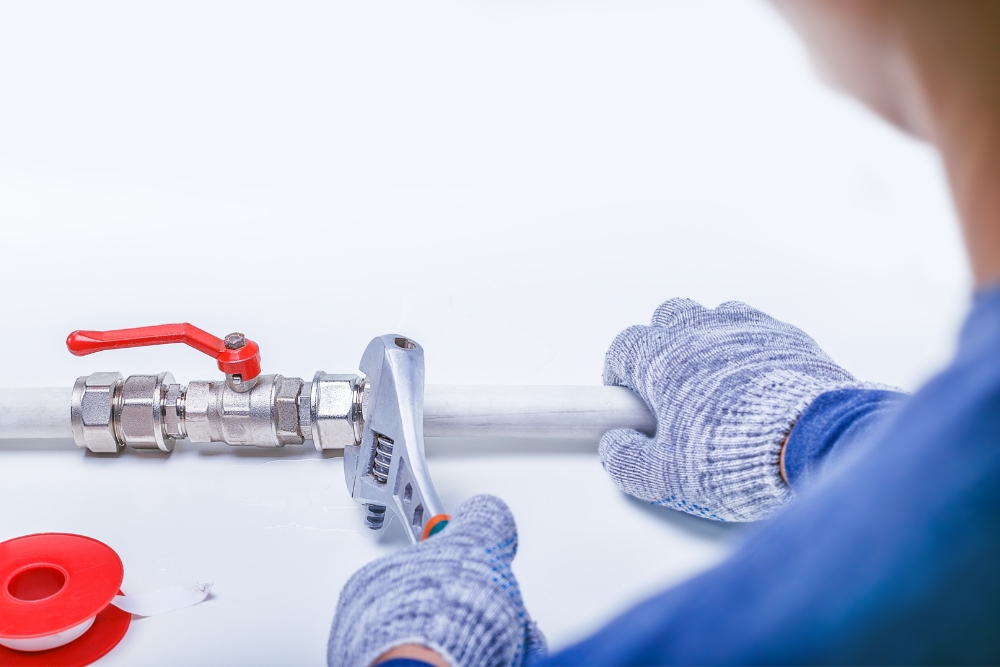
We must not overlook discoloured water and immediately seek professional assistance for safety and performance assessments.
Gas appliances require proper ventilation to avoid health hazards. Professional checks ensure that flue systems are functioning correctly, preventing dangerous fumes from entering your indoor environment.
Signs of Dangerous Problems
We must be aware of the signs that indicate dangerous problems with our hot water service flue or ventilation. These signs can signal serious issues that need immediate attention:
- Discolouration of the area around the water heater may indicate a ventilation problem causing harmful fumes to escape into your home.
- Visible soot around the water heater or on nearby surfaces, suggesting improper venting and potential carbon monoxide leaks.
- Unusual odours, particularly strong gas smells or strange odours near the water heater, indicate a potential gas leak and improper ventilation.
- Persistent pilot light outages or yellow instead of blue flames on the burner, indicate inadequate airflow and potential buildup of dangerous gases.
It is essential to address any of these warning signs promptly to ensure the safety and well-being of your household.
Backdrafting Concerns
When a gas appliance’s flue or ventilation system malfunctions, back draughting can occur, leading to the reversal of airflow. This means that harmful combustion by-products, including carbon monoxide, may be forced into your living space rather than safely vented outside.
Symptoms of exposure to these gases can include headaches, dizziness, nausea, and fatigue. Address any signs of back draughting immediately and seek professional assistance to rectify the issue.
Gas heater safety checks are crucial to ensure proper ventilation and prevent the risks associated with back draughting.
Troubleshooting Common Flue and Ventilation Problems
Check for any obstructions in your flue or chimney, such as debris or bird nests, to ensure proper airflow. To learn more about troubleshooting common flue and ventilation problems, keep reading!
Open Windows or Vents
Ensure that windows or vents are open when using gas appliances to maintain proper ventilation. This allows fresh air to enter the space and ensures that any harmful fumes produced by the appliance are effectively vented outside.
By keeping windows or vents open, you can help prevent a build-up of dangerous gases indoors and promote a healthier and safer living environment for your family.
Regularly check and ensure that all windows or vents near gas appliances are unobstructed at all times. This simple practice can significantly contribute to the safe operation of your hot water system, as well as other gas appliances in your home, reducing the risk of potential health hazards associated with poor ventilation.
Flue and Chimney Inspection
Before moving on to flue and chimney inspection, it’s important to understand the significance of maintaining proper ventilation for your water heater. Flues are designed to direct harmful fumes outside, ensuring the safe operation of gas appliances like hot water systems.
When conducting a flue and chimney inspection, check for any blockages or obstructions that could impede the flow of exhaust gases. Look out for signs of corrosion or damage in the flue pipe as well.
Keeping your flue and chimney clear from any debris or build-up is crucial in preventing back draughting issues and maintaining a safe environment for you and your family.
Contacting a Professional
If you notice any signs of flue or ventilation issues with your hot water system, it is essential to contact a professional gas fitter or plumber promptly. A qualified technician can conduct a thorough inspection to identify the root cause of the problem and provide the necessary repairs or maintenance.
When addressing flue and ventilation concerns, it’s crucial to rely on experts who understand the specific requirements for gas appliances and heating systems, ensuring that any issues are resolved safely and effectively.
When experiencing problems with flues or ventilation in your hot water service, reaching out to an appliance repair specialist is paramount for maintaining the safety and efficiency of your system.
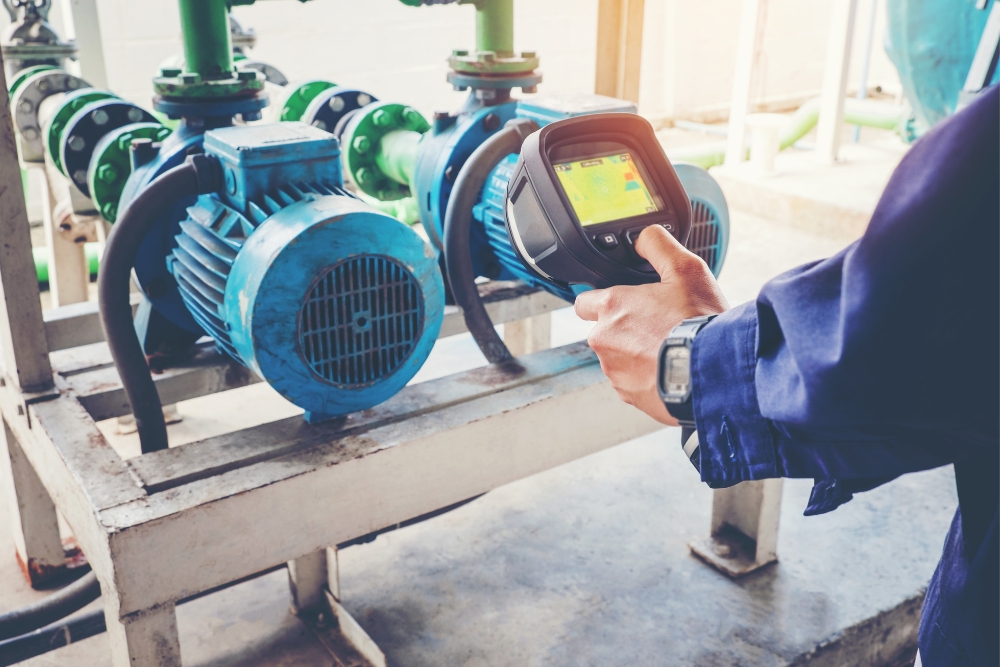
DIY Maintenance for Flues and Ventilation
Regular cleaning and maintenance are essential to keep your flues and ventilation systems working efficiently. Proper use and care, along with knowing when to upgrade your water heater, will help in preventing potential issues.
Proper Use and Care
To ensure the safe and efficient operation of your gas hot water system, it is essential to adhere to proper use and care practices. Regular cleaning and maintenance of the flue and ventilation components are crucial for preventing dangerous fume accumulation indoors.
By staying proactive with maintenance, such as ensuring open windows or vents during operation and scheduling professional inspections, you can safeguard your home against potential safety risks associated with inadequate ventilation.
Furthermore, understanding when to upgrade your water heater is important for maintaining a healthy indoor environment. Upgrading to a newer model can provide improved safety features and better energy efficiency while addressing any existing ventilation issues.
Regular Cleaning and Maintenance
Regular cleaning and maintenance of your hot water service flue or ventilation system is crucial for ensuring the safe and efficient operation of your gas appliance. By scheduling regular inspections and cleanings, you can prevent the build-up of debris, blockages, or corrosion that could compromise proper ventilation.
It’s important to keep the flue terminal clear from any obstructions to allow exhaust gases to vent outside effectively. Additionally, conducting routine checks on the entire flue system helps in identifying potential issues early on, ultimately contributing to a safer environment within your home.
To maintain a healthy and secure indoor space, we recommend homeowners adhere to a schedule of regular maintenance as per manufacturer guidelines. This may involve clearing out dust or dirt accumulation around vents and terminals while also checking for signs of wear or damage.
When to Upgrade Your Water Heater
After performing regular cleaning and maintenance on your water heater, it’s important to consider an upgrade when the unit is approaching the end of its lifespan or if you notice a significant decrease in efficiency.
An aging water heater may struggle to provide an adequate supply of hot water or show signs of deterioration such as rusting, leaking, or strange noises. If your energy bills are increasing due to the inefficiency of your current system, upgrading to a more energy-efficient model can result in long-term cost savings and improved performance.
Keep in mind that technological advancements have made modern water heaters more efficient and environmentally friendly, offering benefits such as faster heating times and better temperature control.
Staying Safe and Secure in Your Home
Understanding the Risks Helps You Stay Safe. Regular Maintenance is Essential for Safety.
Understanding the Risks
Flue and ventilation issues pose significant safety risks for homeowners. Inadequate ventilation can lead to harmful fumes, such as carbon monoxide, accumulating indoors, which can result in serious health concerns.
Without proper fleeing, gas appliances like hot water systems may emit toxic gases into living spaces, putting occupants at risk of poisoning. It’s crucial to be aware of these risks and prioritise regular maintenance and professional inspections to ensure the safe operation of gas appliances in the home.
Gas heating safety checks are essential aspects of homeownership to guarantee that flues and ventilation requirements are met for the reliable and secure functioning of hot water systems.
Importance of Regular Maintenance
Regular maintenance of your hot water system’s flue and ventilation is crucial for the safety and efficiency of your gas appliance. By ensuring that your flue is clear from blockages and properly vented, you can prevent harmful fumes from accumulating indoors.
This regular maintenance not only supports a healthy indoor environment but also helps avoid potential risks associated with restricted airflow or reversed flue flow, which can lead to serious safety concerns.
Maintaining proper ventilation and conducting routine checks on your water heater’s flue terminal are essential steps in preventing dangerous issues such as back-drafting or gas heater poisoning.
Contacting a Water Heater Expert
Ensuring the safety and efficiency of your hot water system is crucial. When experiencing flue or ventilation issues with your water heater, it’s essential to contact a qualified water heater expert promptly.
A professional can conduct a thorough inspection and diagnose any problems that may be compromising the proper functioning of your flue or ventilation system, ensuring that your gas appliance operates safely and effectively.
Expert intervention is critical when dealing with potential carbon monoxide exposure or addressing any signs of back draughting concerns.
Swift Resolution for Your Hot Water Needs Today!
Addressing flue and ventilation issues with hot water service is crucial for the safety of your home. Regular maintenance and prompt professional attention are necessary to prevent dangerous problems.
Stay proactive in ensuring proper flueing for your hot water system to maintain a secure and healthy indoor environment. Contact a water heater expert as soon as you notice any signs of flue or ventilation issues, prioritising the safety and well-being of your household.
Are you experiencing issues with your hot water service flue or ventilation system? Don’t ignore the signs of ventilation problems, as they can lead to serious safety hazards. Contact Hot Water Repairs Today for expert assistance in diagnosing and resolving flue or ventilation issues.



